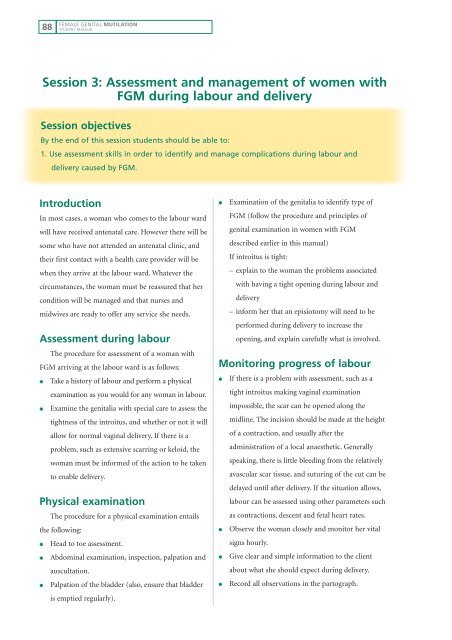Female Genital Mutilation - World Health Organization
Female Genital Mutilation - World Health Organization
Female Genital Mutilation - World Health Organization
Create successful ePaper yourself
Turn your PDF publications into a flip-book with our unique Google optimized e-Paper software.
88<br />
FEMALE GENITAL MUTILATION<br />
STUDENT MANUAL<br />
Session 3: Assessment and management of women with<br />
FGM during labour and delivery<br />
Session objectives<br />
By the end of this session students should be able to:<br />
1. Use assessment skills in order to identify and manage complications during labour and<br />
delivery caused by FGM.<br />
Introduction<br />
In most cases, a woman who comes to the labour ward<br />
will have received antenatal care. However there will be<br />
some who have not attended an antenatal clinic, and<br />
their first contact with a health care provider will be<br />
when they arrive at the labour ward. Whatever the<br />
circumstances, the woman must be reassured that her<br />
condition will be managed and that nurses and<br />
midwives are ready to offer any service she needs.<br />
Assessment during labour<br />
The procedure for assessment of a woman with<br />
FGM arriving at the labour ward is as follows:<br />
● Take a history of labour and perform a physical<br />
examination as you would for any woman in labour.<br />
● Examine the genitalia with special care to assess the<br />
tightness of the introitus, and whether or not it will<br />
allow for normal vaginal delivery. If there is a<br />
problem, such as extensive scarring or keloid, the<br />
woman must be informed of the action to be taken<br />
to enable delivery.<br />
Physical examination<br />
The procedure for a physical examination entails<br />
the following:<br />
● Head to toe assessment.<br />
● Abdominal examination, inspection, palpation and<br />
auscultation.<br />
● Palpation of the bladder (also, ensure that bladder<br />
is emptied regularly).<br />
● Examination of the genitalia to identify type of<br />
FGM (follow the procedure and principles of<br />
genital examination in women with FGM<br />
described earlier in this manual)<br />
If introitus is tight:<br />
– explain to the woman the problems associated<br />
with having a tight opening during labour and<br />
delivery<br />
– inform her that an episiotomy will need to be<br />
performed during delivery to increase the<br />
opening, and explain carefully what is involved.<br />
Monitoring progress of labour<br />
● If there is a problem with assessment, such as a<br />
tight introitus making vaginal examination<br />
impossible, the scar can be opened along the<br />
midline. The incision should be made at the height<br />
of a contraction, and usually after the<br />
administration of a local anaesthetic. Generally<br />
speaking, there is little bleeding from the relatively<br />
avascular scar tissue, and suturing of the cut can be<br />
delayed until after delivery. If the situation allows,<br />
labour can be assessed using other parameters such<br />
as contractions, descent and fetal heart rates.<br />
● Observe the woman closely and monitor her vital<br />
signs hourly.<br />
● Give clear and simple information to the client<br />
about what she should expect during delivery.<br />
● Record all observations in the partograph.

















